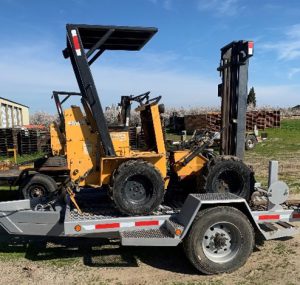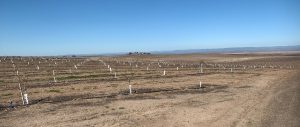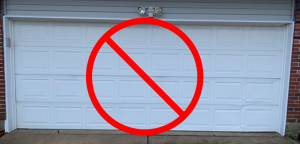Part 3 – Where Do I Put It?
By: James Masucci
This February, I had the opportunity to tour the almond pollination with John Miller, of Miller Honey Farms, and Sandy Honigsberg, a beekeeper in the El Dorado bee club. “So, besides feeding, what other problems are you dealing with as you are expanding?” The question came from Sandy on my first day in CA. Sandy is in a similar place in her career, looking at how to make beekeeping her full-time endeavor. That question hit the nail on the head. It’s in part why I’m here. Suck out as much information from the experts to help me make the transition from large hobbyist to large side-liner/small commercial. Maybe, a good starting point is coming up with a good answer to the question.

Syrup vs. dry sugar. At some point during my expansion, I will need to convert from mixing my own syrup to buying syrup in totes. Totes will save time and help prevent back injuries from lifting thousands of pounds of sugar.
 The topic of feeding came up as I was explaining why I’m having a rough Winter. I make mid-Summer splits for mite control and to expand. Because of Covid (always need to blame something, right?), I couldn’t buy sugar when the bees needed it. Therefore, my bees went into the Winter small and light. John offered his first of many gems, “check out soda manufacturers in the area. They get tankers of syrup, you can buy totes from them”. When I explained that I get 50 pound bags of sugar from Restaurant Depot, I got the, “oh, you still mix your own syrup?” If I’m going to expand, I need to focus on the bees and not menial tasks that can be easily avoided. At some point, I will need to buy syrup and not dry sugar.
The topic of feeding came up as I was explaining why I’m having a rough Winter. I make mid-Summer splits for mite control and to expand. Because of Covid (always need to blame something, right?), I couldn’t buy sugar when the bees needed it. Therefore, my bees went into the Winter small and light. John offered his first of many gems, “check out soda manufacturers in the area. They get tankers of syrup, you can buy totes from them”. When I explained that I get 50 pound bags of sugar from Restaurant Depot, I got the, “oh, you still mix your own syrup?” If I’m going to expand, I need to focus on the bees and not menial tasks that can be easily avoided. At some point, I will need to buy syrup and not dry sugar.
But this little transition, from sugar to syrup, highlights all the other issues I need to figure out. I have an F150. I love the truck. It has a payload rating of around 1500 pounds. Plenty for 50-pound bags of sugar, but a 300 gallon tote of syrup is over 3500 pounds. Not going to work. Next, I go to the source, get my tote, and drive home. How many neighbors does it take to move a 3500-pound tote? Ugh, I need a truck AND a forklift. I was thinking that since I’m not a migratory beekeeper and don’t move hives around, much, I could get away with a pickup and maybe a trailer. Certainly, many of my daily activities and hive checks can be done with my pickup. But there will be times, like now when I’m cleaning out yards full of empty boxes, when a bee truck and a forklift will greatly facilitate my job. First, for feeding. Make it fast and easy. Second, for moving bees and equipment. How many trips between yards do I need to make? Third, for transporting honey supers. Again, I can take several trips with my F150 or one trip with a bee truck. Finally, and maybe most importantly, to save my back. As I get older, I’m going to hurt my back lifting. I need to minimize that. Utilizing pallets and a forklift will minimize the heavy lifting and, hopefully, prolong my beekeeping career.

Converting to sugar syrup will require a forklift to move the tote and a “tonner” flatbed to transport it. Cha-ching. But they will also help in moving hives and honey supers. The F550 or 5500 class of flatbeds can handle 80 double-deep hives. Rather than making multiple trips to all my yards, the truck can handle all that I need to carry. The forklift uses hydraulics instead of spine and back muscles. The former is much easier to repair.
 The next, big change associated with expanding was highlighted by George Carlin. I need a place for my stuff! My garage is full. I inherited a small container and that is already full. I haven’t even expanded, yet, and I’m out of space. I live in suburbia, so I can’t park my bee truck and forklift on the street. Then, there’s the whole honey-house side of things. In MO, if you sell more than $50,000 of honey you are considered commercial and must have a health-inspected facility to extract. So, if I expand as much as I want to, I can’t just buy a piece of property in the middle of nowhere and store all my stuff there. I need water, sewer, electricity, and a building with the right zoning and structural make-up.
The next, big change associated with expanding was highlighted by George Carlin. I need a place for my stuff! My garage is full. I inherited a small container and that is already full. I haven’t even expanded, yet, and I’m out of space. I live in suburbia, so I can’t park my bee truck and forklift on the street. Then, there’s the whole honey-house side of things. In MO, if you sell more than $50,000 of honey you are considered commercial and must have a health-inspected facility to extract. So, if I expand as much as I want to, I can’t just buy a piece of property in the middle of nowhere and store all my stuff there. I need water, sewer, electricity, and a building with the right zoning and structural make-up.
Let’s summarize. That’s a truck, a forklift, a piece of property, and a honey house. That’s after just being told during one of my CA trip meet and greets that people who are in the business for thirty years (referring to almond growers but John agreed it pertains to beekeeping as well) should expect to go bankrupt twice in that time. WHAT? What am I thinking? Why would anyone do this?

Investment in the future: It costs an almond grower about $6,000 per acre to plant and $1,000 per acre in inputs per year to establish a bearing fruit crop. I’m sure this picture represents over a million dollars of investment. Every business takes investment to succeed. The trick is to truly understand the risks vs the reward before taking the leap.
Here, too, my trip was invaluable. Not only was I getting sage advice about all the things I should consider, but I was observing almonds and pollination at an incredible scale. 1.2 million bearable almond acres with two hives per acre. I learned that it costs $6,000 to plant an acre of almonds and a $9,000-$11,000 investment before you even start to produce almonds. It takes about nine years to break even. Yet, almonds are the most lucrative crop in CA. I really began to understand that it takes investment to be “successful”. Even John, who is fourth generation beekeeper, just invested an enormous amount of money on a climate-controlled warehouse to overwinter his bees in North Dakota. I have a lot of respect for people who have the courage to invest in their own business. In my career as a scientist, I got paid whether the company had a good year or not. The worst that could have happened to me was that I lose my job. There was no way I was going to go bankrupt twice in my career. Then it hit me, I did make an investment in my career. I went in debt to get a great college education. I spent six years in graduate school and five years as a post-doctoral fellow. I didn’t get my first job until I was in my early 30s.

I’m out of space: My container is full of hive components. My garage, (my wife won’t allow a picture of the inside) is full of extracting equipment, sugar, buckets, etc. I’m out-growing the garage as my “honey house.” My current size already has used up our available space. Any growth requires more…
 Maybe my dice were a little loaded, but I did roll them for my “success”. I did it once, I guess it’s time to do it again. I’ve already decided that I am not a high stakes gambler. I won’t put my retirement in jeopardy for this endeavor. But I am going to make some investments to allow me to expand – at least to give it a go as a serious sideliner. Next step? A place for my stuff.
Maybe my dice were a little loaded, but I did roll them for my “success”. I did it once, I guess it’s time to do it again. I’ve already decided that I am not a high stakes gambler. I won’t put my retirement in jeopardy for this endeavor. But I am going to make some investments to allow me to expand – at least to give it a go as a serious sideliner. Next step? A place for my stuff.
Click here to go directly to Part 2 – What’s in a Queen?
Click here to go directly to Part 4 – A Shout Out to My Friends





